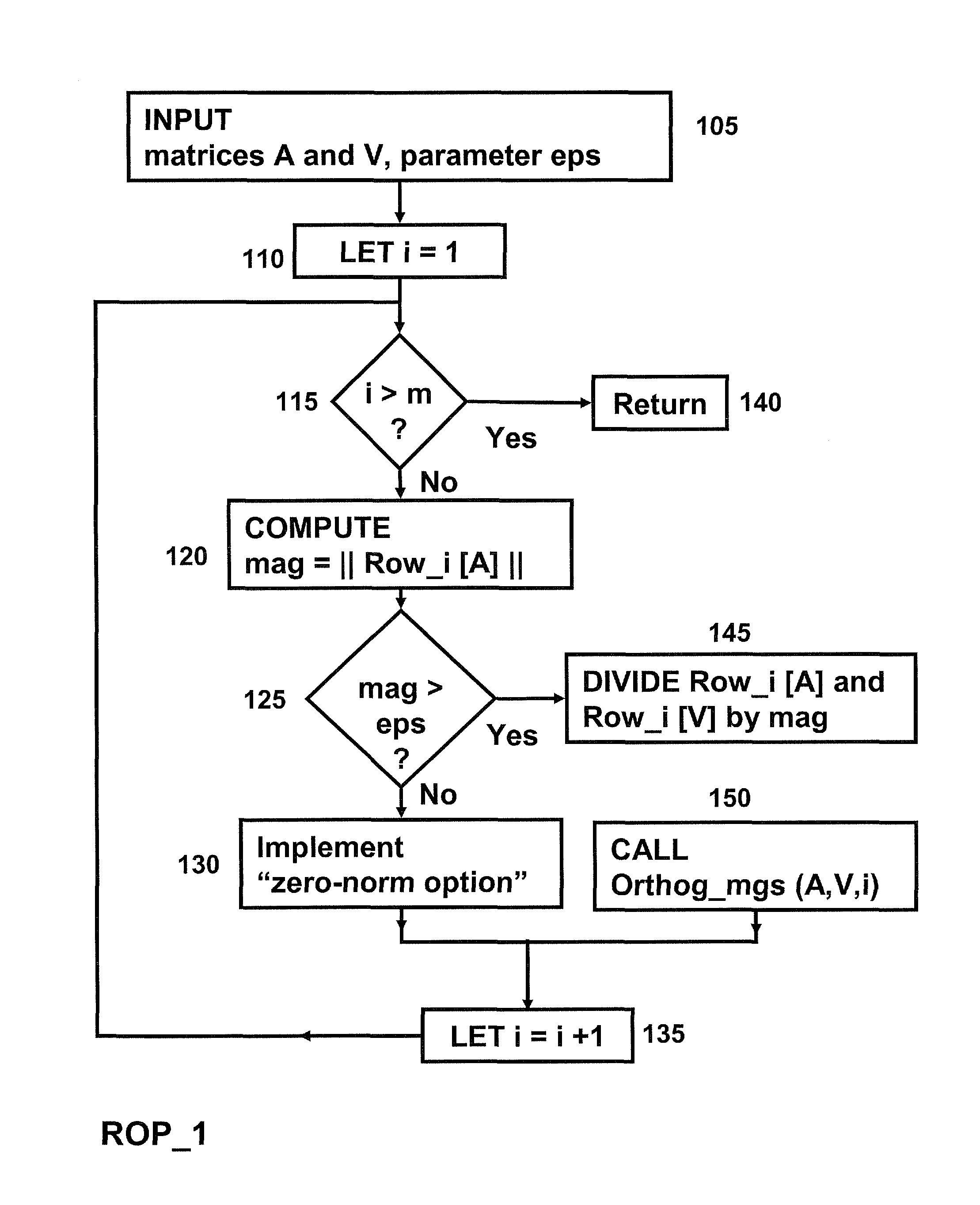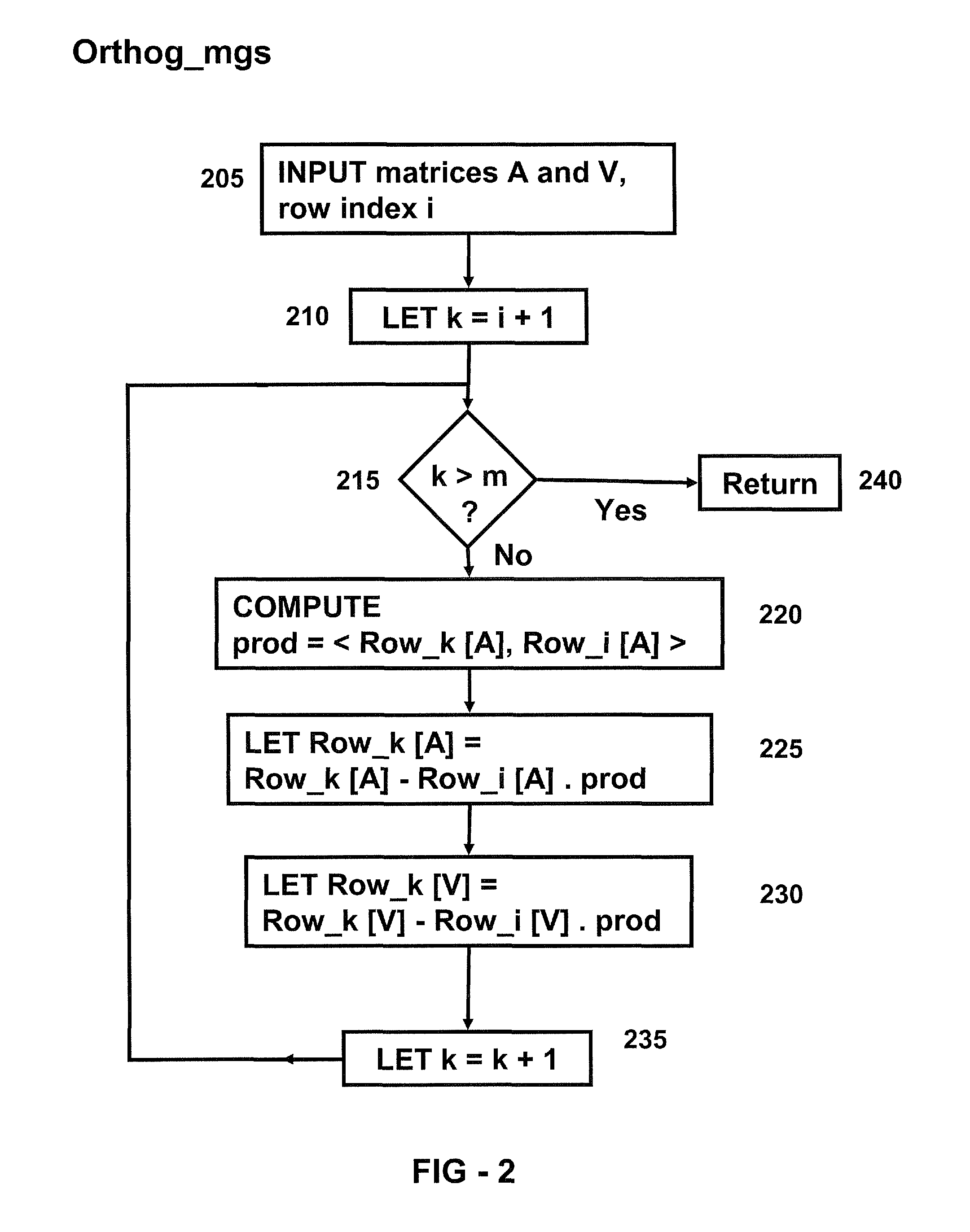Systems and methods for reducing memory traffic and power consumption in a processing environment by solving a system of linear equations
- Summary
- Abstract
- Description
- Claims
- Application Information
AI Technical Summary
Benefits of technology
Problems solved by technology
Method used
Image
Examples
embodiment # 4
Embodiment #4
[0166]This fourth embodiment solves AX=B in the real-time case (i.e., “online”, as the data arrives). It operates on AX=B by directly applying the row operations to A and B, and performs incremental updating of the solution. The ideal application for this algorithm is one in which the data (i.e., corresponding rows of A and B) become available on a relatively slow time scale. This could happen, for example, if the computer is input / output-limited, if it takes a long time to compute the rows of A and / or B, or if it takes a long time to compute the solution relative to the time required to access the rows of A and / or B in one or more memory modules. The solution can be incrementally updated as corresponding subsets of one or more rows of A and B (e.g., rows 1 and 2 of A and rows 1 and 2 of B) become available to the processors(s). The availability of the corresponding rows may be limited by many factors, such as the rows of A and / or B being moved into memory at a relative...
embodiment # 1
Embodiment #1
[0259]An application of this first embodiment is to solve a consistent system of linear equations for general A and for possibly multiple instances of b. The flowchart for this embodiment is essentially FIG. 35, but some additional words are useful. In 3520, the storage that is created could, for example, be for M, x, N, and arrays for pivot locations. Also, the initialization that is done at 3520 could be for the number of pivots, for example. The row operations that were done in 3530 are shown in more detail in FIG. 40, in which partial pivoting is used. The variable t in 4015 denotes the value of i for which |aij| is largest; this determines the pivot point for the j-th column. Note that while the row operations are decided on by the content in A (cf. 4015, 4020), the operations themselves are applied to both A and M (cf. 4030, 4035, 4040). These operations are the usual ones, consisting of linear transformations on the row vectors of A and M. Also, 3540 may be effic...
embodiment # 2
Embodiment #2
[0266]This second embodiment is a specific case of the flowchart given in FIG. 36, in which 3640 and 3660 are computed concurrently. The algorithm begins at 4110 with the user supplying A; the dimensions m, n, and p; the feature set; and eps. At 4120, initializations are done, such as setting M equal to an m×m identity matrix (Im), creating storage for the array c, and initializing variables and arrays that will track the locations of the pivot points. At 4130, two processes are executed concurrently: the row operations on A and M at 4140, and the computation of Mb at 4150. While 4140 is working on the i-th row of A, 4150 is working on the (i−1)-st row of M. Thus 4140 and 4150 operate essentially concurrently; a single remaining step in the computation of Mb is done at 4160. Note that there are other ways to overlap 4140 and 4150. Next, at 4170, the system of equations represented by A′ x=c are solved; this part is standard since A′ is in row echelon form. At 4180, the ...
PUM
 Login to View More
Login to View More Abstract
Description
Claims
Application Information
 Login to View More
Login to View More - R&D
- Intellectual Property
- Life Sciences
- Materials
- Tech Scout
- Unparalleled Data Quality
- Higher Quality Content
- 60% Fewer Hallucinations
Browse by: Latest US Patents, China's latest patents, Technical Efficacy Thesaurus, Application Domain, Technology Topic, Popular Technical Reports.
© 2025 PatSnap. All rights reserved.Legal|Privacy policy|Modern Slavery Act Transparency Statement|Sitemap|About US| Contact US: help@patsnap.com



